Cool RENAULT SCENIC 2000 J64 / 1.G Technical Note 3426A User Guide
[x] Cancel search | Manufacturer: RENAULT, Model Year: 2000, Model line: SCENIC, Model: RENAULT SCENIC 2000 J64 / 1.GPages: 118, PDF Size: 1.5 MB
Page 54 of 118
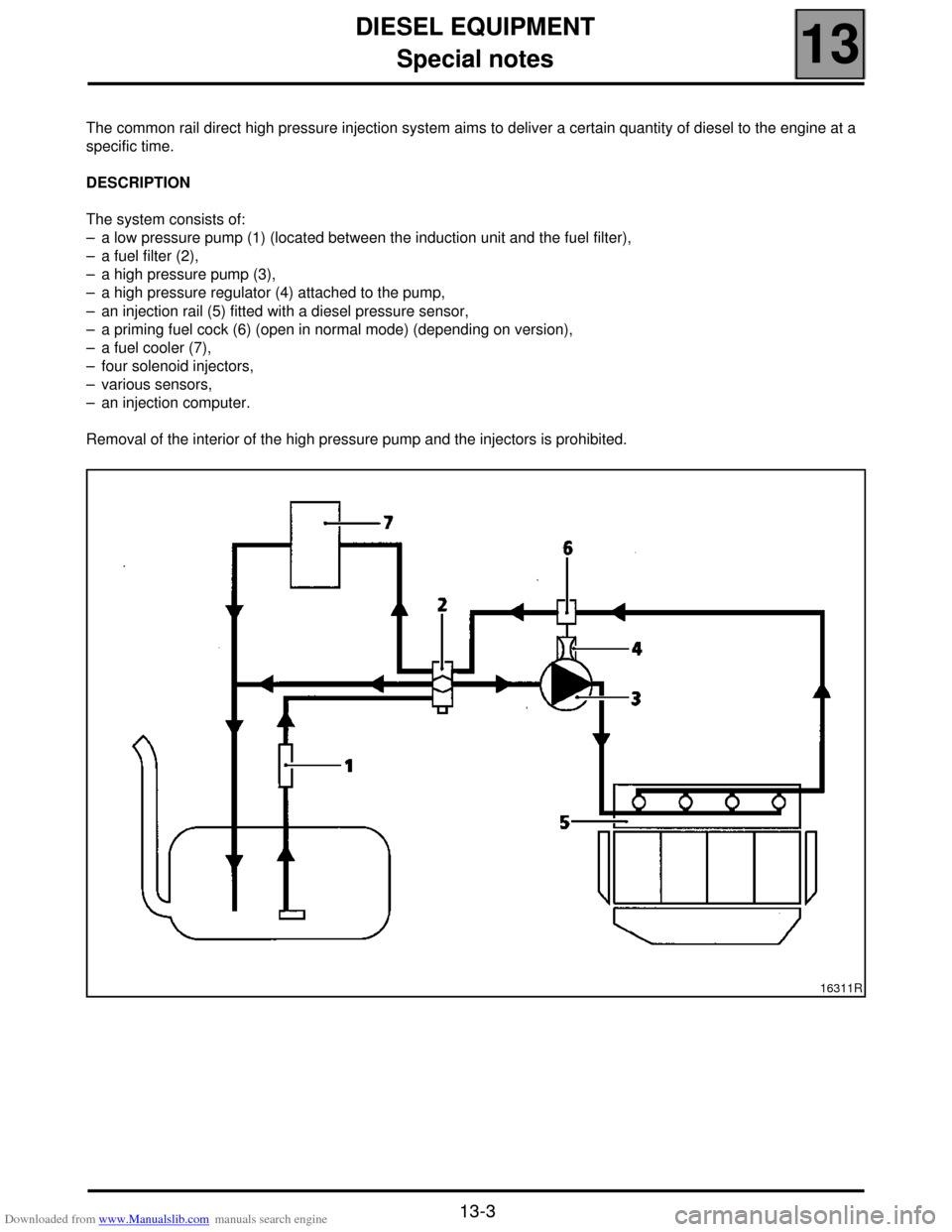
Downloaded from www.Manualslib.com manuals search engine DIESEL EQUIPMENT
Special notes
13
13-3
Special notes
The common rail direct high pressure injection system aims to deliver a certain quantity of diesel to the engine at a
specific time.
DESCRIPTION
The system consists of:
– a low pressure pump (1) (located between the induction unit and the fuel filter),
– a fuel filter (2),
– a high pressure pump (3),
– a high pressure regulator (4) attached to the pump,
– an injection rail (5) fitted with a diesel pressure sensor,
– a priming fuel cock (6) (open in normal mode) (depending on version),
– a fuel cooler (7),
– four solenoid injectors,
– various sensors,
– an injection computer.
Removal of the interior of the high pressure pump and the injectors is prohibited.
16311R
Page 60 of 118
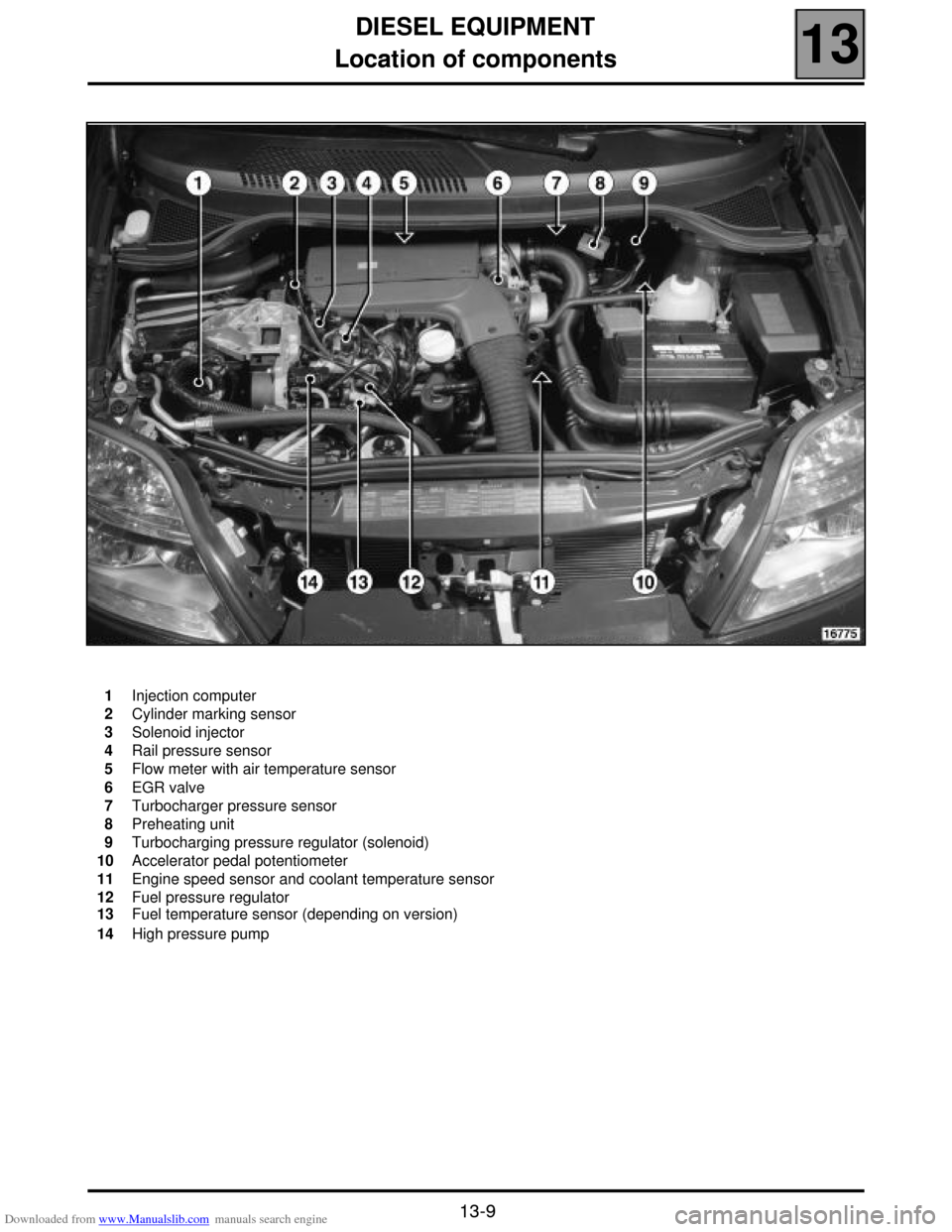
Downloaded from www.Manualslib.com manuals search engine DIESEL EQUIPMENT
Location of components
13
13-9
Location of components
1
2
3
4
5
6
7
8
9
10
11
12
13
14Injection computer
Cylinder marking sensor
Solenoid injector
Rail pressure sensor
Flow meter with air temperature sensor
EGR valve
Turbocharger pressure sensor
Preheating unit
Turbocharging pressure regulator (solenoid)
Accelerator pedal potentiometer
Engine speed sensor and coolant temperature sensor
Fuel pressure regulator
Fuel temperature sensor (depending on version)
High pressure pump
Page 66 of 118

Downloaded from www.Manualslib.com manuals search engine DIESEL EQUIPMENT
Injection/air conditioning programming
13
13-15
COMPRESSOR OPERATION PROGRAMMING
During certain stages of operation, the diesel injection computer stops the compressor from functioning.
Engine start programming
The compressor is prevented from operating for 5 seconds after the engine has started.
Recovery of performance
When the position of the accelerator pedal is changed significantly and if the engine speed is less than 3000 rpm,
the compressor is prevented from operation for 5 seconds.
Recovery of output when the vehicle starts moving
If the position of the potentiometer is more than 50 % the engine speed is less than 2250 rpm and the vehicle speed
is below 20 km/h, the compressor is cut for 5 seconds.
Anti-stall protection
If the no load position is not detected, and the engine speed is less than 675 rpm. the compressor is disengaged. It
is engaged again after 5 seconds if the engine speed is increased.
Thermal protection programming
The compressor does not engage in cases where the coolant temperature is greater than + 112 °C.
Page 67 of 118
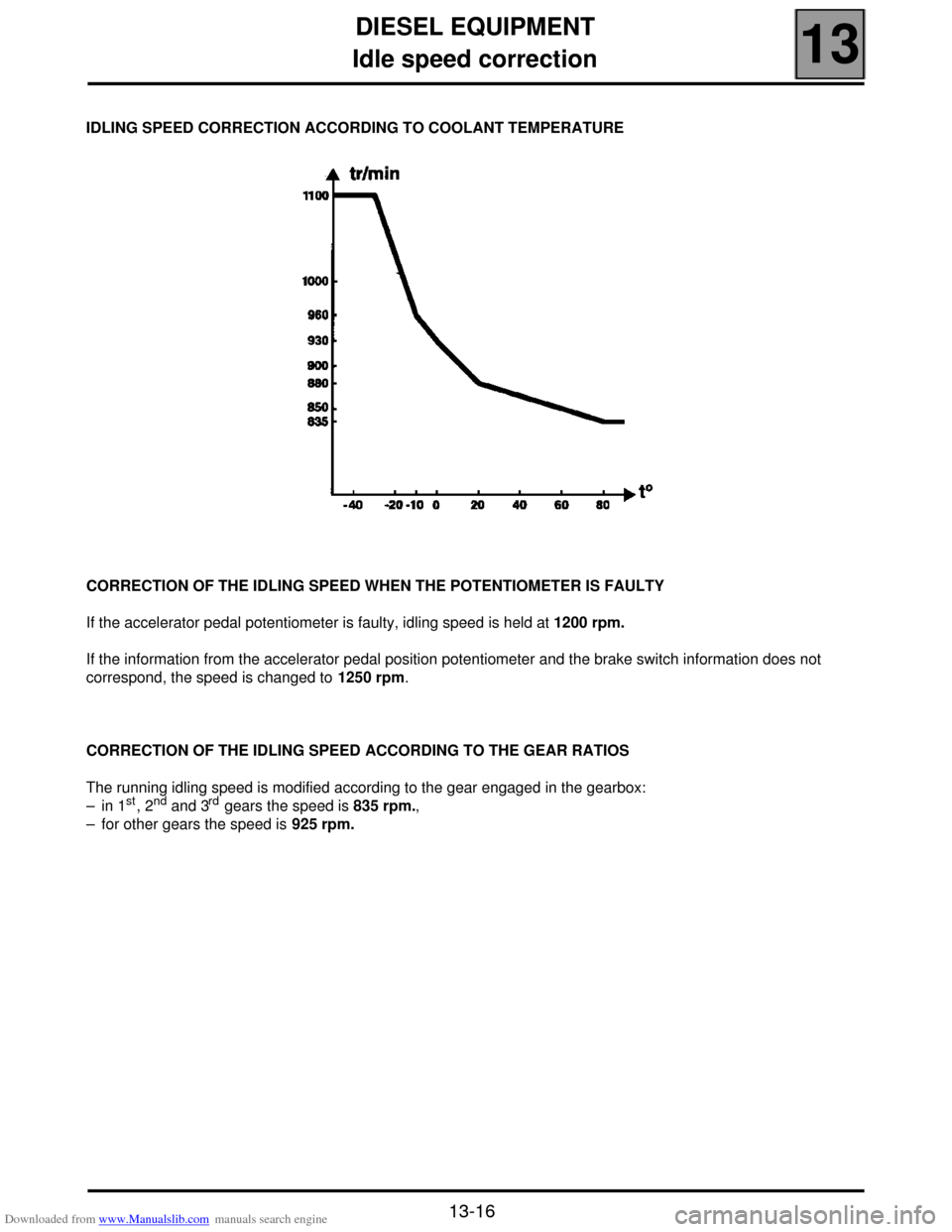
Downloaded from www.Manualslib.com manuals search engine DIESEL EQUIPMENT
Idle speed correction
13
13-16
Idle speed correction
IDLING SPEED CORRECTION ACCORDING TO COOLANT TEMPERATURE
CORRECTION OF THE IDLING SPEED WHEN THE POTENTIOMETER IS FAULTY
If the accelerator pedal potentiometer is faulty, idling speed is held at 1200 rpm.
If the information from the accelerator pedal position potentiometer and the brake switch information does not
correspond, the speed is changed to 1250 rpm.
CORRECTION OF THE IDLING SPEED ACCORDING TO THE GEAR RATIOS
The running idling speed is modified according to the gear engaged in the gearbox:
– in 1
st, 2nd and 3rd gears the speed is 835 rpm.,
– for other gears the speed is 925 rpm.
Page 68 of 118
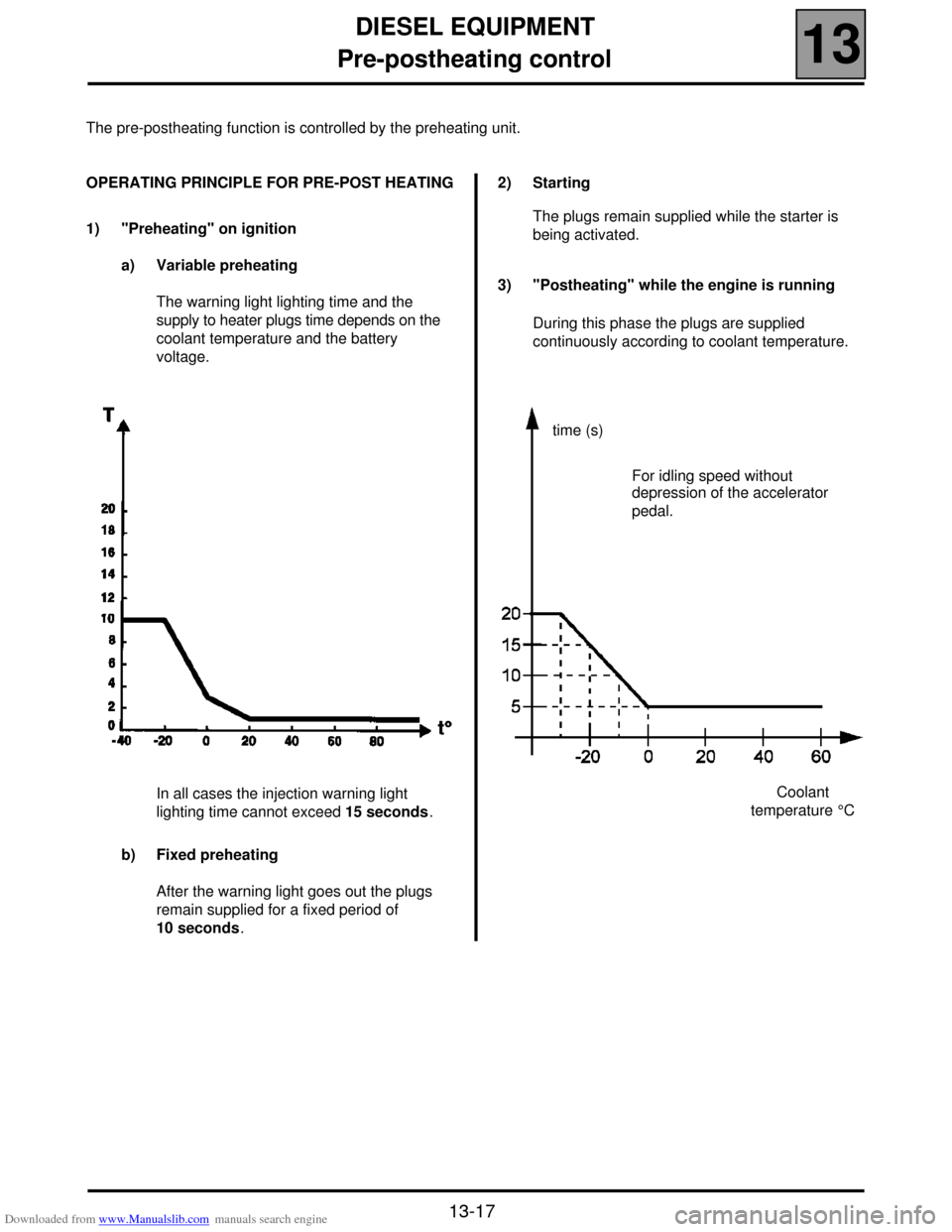
Downloaded from www.Manualslib.com manuals search engine DIESEL EQUIPMENT
Pre-postheating control
13
13-17
Pre-postheating control
The pre-postheating function is controlled by the preheating unit.
OPERATING PRINCIPLE FOR PRE-POST HEATING
1) "Preheating" on ignition
a) Variable preheating
The warning light lighting time and the
supply to heater plugs time depends on the
coolant temperature and the battery
voltage.
In all cases the injection warning light
lighting time cannot exceed 15 seconds.
b) Fixed preheating
After the warning light goes out the plugs
remain supplied for a fixed period of
10 seconds.2) Starting
The plugs remain supplied while the starter is
being activated.
3) "Postheating" while the engine is running
During this phase the plugs are supplied
continuously according to coolant temperature.
time (s)
Coolant
temperature °C For idling speed without
depression of the accelerator
pedal.
Page 70 of 118
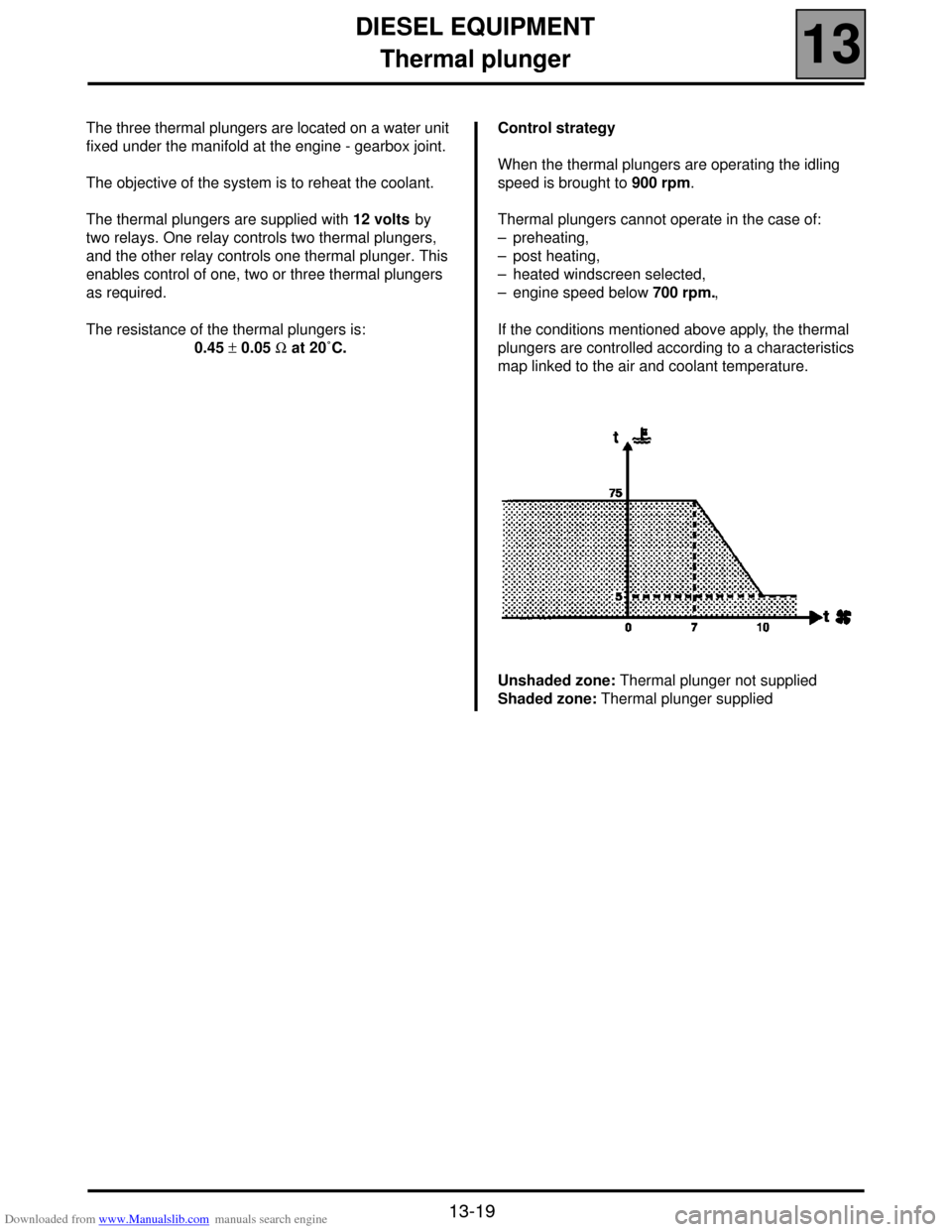
Downloaded from www.Manualslib.com manuals search engine DIESEL EQUIPMENT
Thermal plunger
13
13-19
Thermal plunger
The three thermal plungers are located on a water unit
fixed under the manifold at the engine - gearbox joint.
The objective of the system is to reheat the coolant.
The thermal plungers are supplied with 12 volts by
two relays. One relay controls two thermal plungers,
and the other relay controls one thermal plunger. This
enables control of one, two or three thermal plungers
as required.
The resistance of the thermal plungers is:
0.45 ± 0.05 Ω at 20˚C. Control strategy
When the thermal plungers are operating the idling
speed is brought to 900 rpm.
Thermal plungers cannot operate in the case of:
– preheating,
– post heating,
– heated windscreen selected,
– engine speed below 700 rpm.,
If the conditions mentioned above apply, the thermal
plungers are controlled according to a characteristics
map linked to the air and coolant temperature.
Unshaded zone: Thermal plunger not supplied
Shaded zone: Thermal plunger supplied
Page 92 of 118
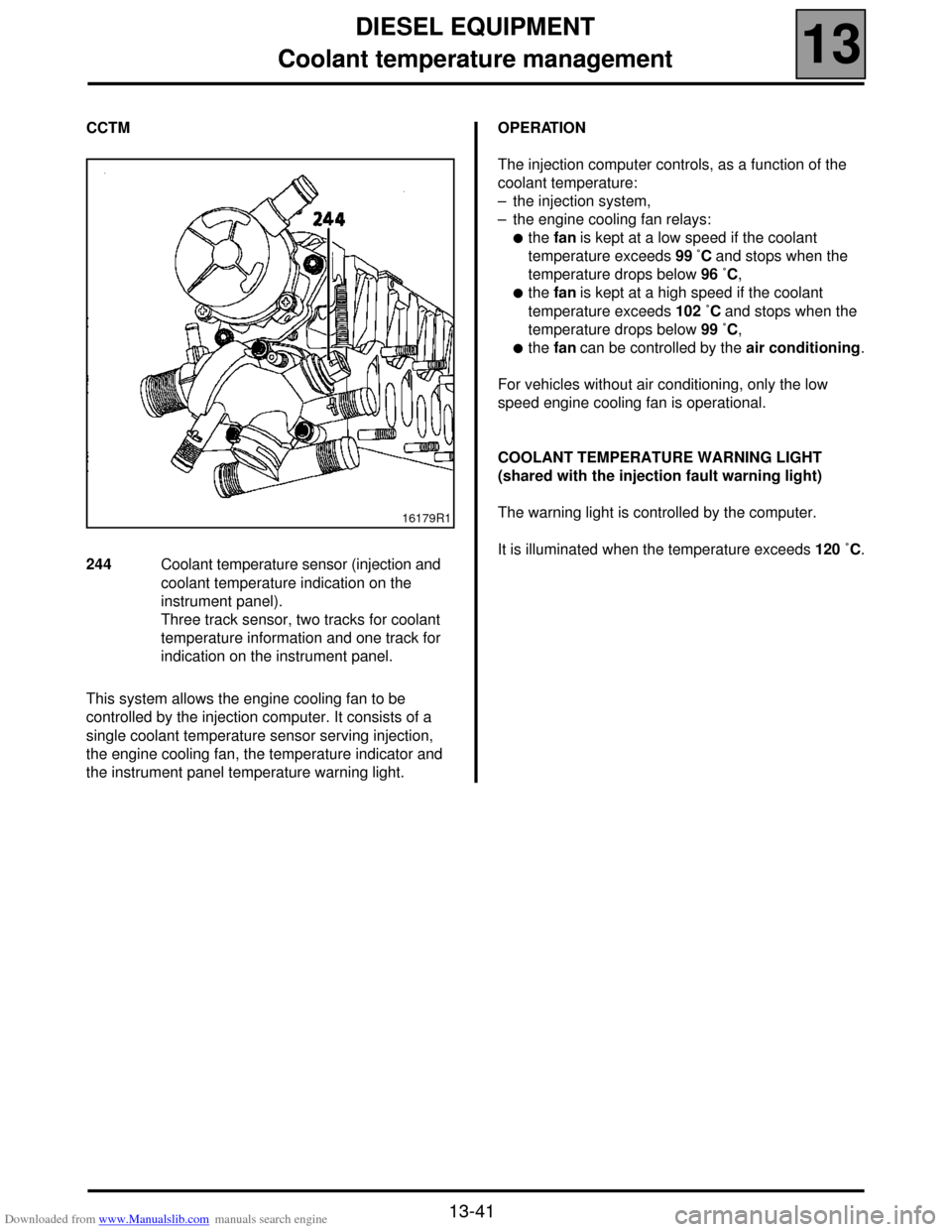
Downloaded from www.Manualslib.com manuals search engine DIESEL EQUIPMENT
Coolant temperature management
13
13-41
Coolant temperature management
CCTM
This system allows the engine cooling fan to be
controlled by the injection computer. It consists of a
single coolant temperature sensor serving injection,
the engine cooling fan, the temperature indicator and
the instrument panel temperature warning light.OPERATION
The injection computer controls, as a function of the
coolant temperature:
– the injection system,
– the engine cooling fan relays:
!the fan is kept at a low speed if the coolant
temperature exceeds 99 ˚C and stops when the
temperature drops below 96 ˚C,
!the fan is kept at a high speed if the coolant
temperature exceeds 102 ˚C and stops when the
temperature drops below 99 ˚C,
!the fan can be controlled by the air conditioning.
For vehicles without air conditioning, only the low
speed engine cooling fan is operational.
COOLANT TEMPERATURE WARNING LIGHT
(shared with the injection fault warning light)
The warning light is controlled by the computer.
It is illuminated when the temperature exceeds 120 ˚C.
16179R1
244 Coolant temperature sensor (injection and
coolant temperature indication on the
instrument panel).
Three track sensor, two tracks for coolant
temperature information and one track for
indication on the instrument panel.
Page 93 of 118
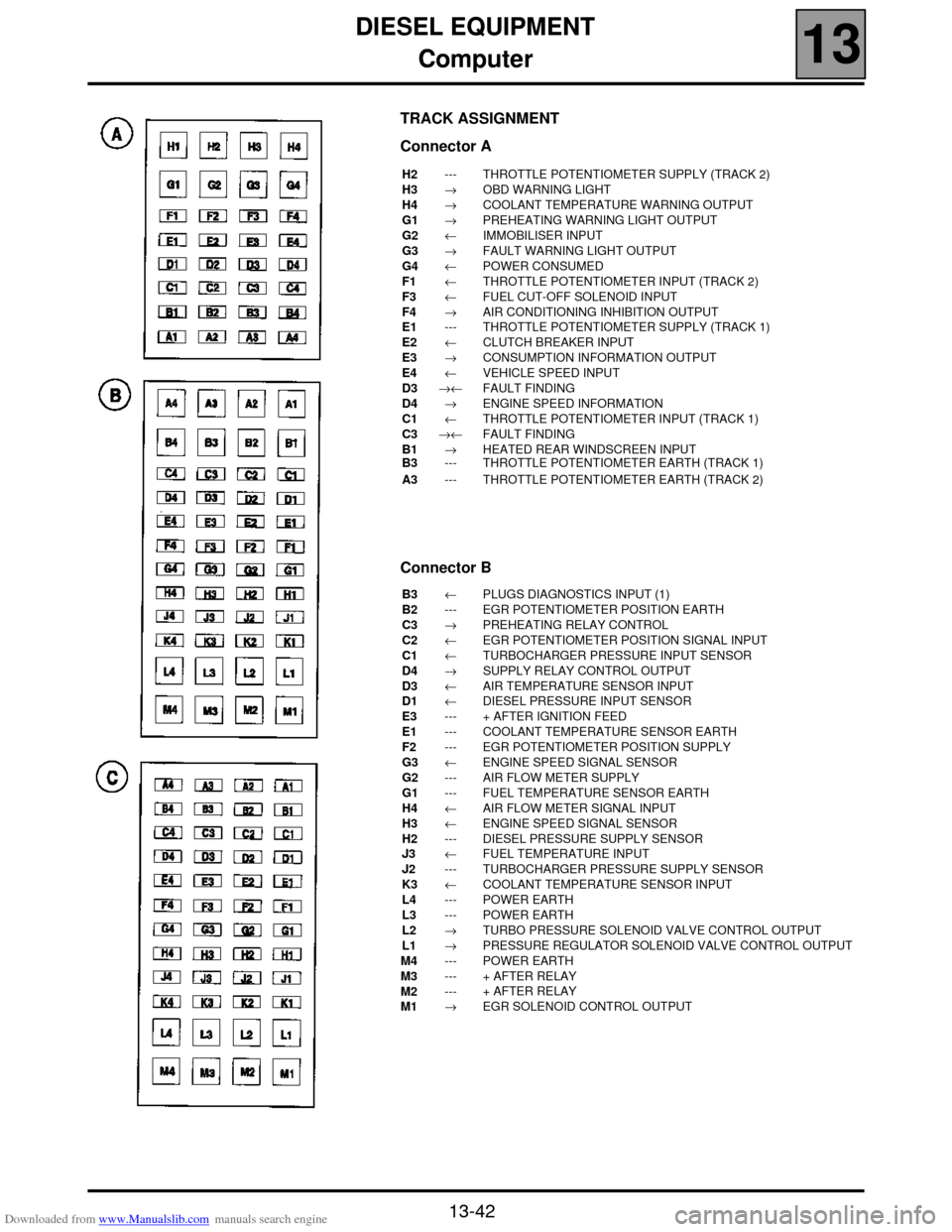
Downloaded from www.Manualslib.com manuals search engine DIESEL EQUIPMENT
Computer
13
13-42
Computer
TRACK ASSIGNMENT
Connector A
H2
H3
H4
G1
G2
G3
G4
F1
F3
F4
E1
E2
E3
E4
D3
D4
C1
C3
B1
B3
A3---
→
→
→
←
→
←
←
←
→
---
←
→
←
→←
→
←
→←
→
---
---THROTTLE POTENTIOMETER SUPPLY (TRACK 2)
OBD WARNING LIGHT
COOLANT TEMPERATURE WARNING OUTPUT
PREHEATING WARNING LIGHT OUTPUT
IMMOBILISER INPUT
FAULT WARNING LIGHT OUTPUT
POWER CONSUMED
THROTTLE POTENTIOMETER INPUT (TRACK 2)
FUEL CUT-OFF SOLENOID INPUT
AIR CONDITIONING INHIBITION OUTPUT
THROTTLE POTENTIOMETER SUPPLY (TRACK 1)
CLUTCH BREAKER INPUT
CONSUMPTION INFORMATION OUTPUT
VEHICLE SPEED INPUT
FAULT FINDING
ENGINE SPEED INFORMATION
THROTTLE POTENTIOMETER INPUT (TRACK 1)
FAULT FINDING
HEATED REAR WINDSCREEN INPUT
THROTTLE POTENTIOMETER EARTH (TRACK 1)
THROTTLE POTENTIOMETER EARTH (TRACK 2)
Connector B
B3
B2
C3
C2
C1
D4
D3
D1
E3
E1
F2
G3
G2
G1
H4
H3
H2
J3
J2
K3
L4
L3
L2
L1
M4
M3
M2
M1←
---
→
←
←
→
←
←
---
---
---
←
---
---
←
←
---
←
---
←
---
---
→
→
---
---
---
→PLUGS DIAGNOSTICS INPUT (1)
EGR POTENTIOMETER POSITION EARTH
PREHEATING RELAY CONTROL
EGR POTENTIOMETER POSITION SIGNAL INPUT
TURBOCHARGER PRESSURE INPUT SENSOR
SUPPLY RELAY CONTROL OUTPUT
AIR TEMPERATURE SENSOR INPUT
DIESEL PRESSURE INPUT SENSOR
+ AFTER IGNITION FEED
COOLANT TEMPERATURE SENSOR EARTH
EGR POTENTIOMETER POSITION SUPPLY
ENGINE SPEED SIGNAL SENSOR
AIR FLOW METER SUPPLY
FUEL TEMPERATURE SENSOR EARTH
AIR FLOW METER SIGNAL INPUT
ENGINE SPEED SIGNAL SENSOR
DIESEL PRESSURE SUPPLY SENSOR
FUEL TEMPERATURE INPUT
TURBOCHARGER PRESSURE SUPPLY SENSOR
COOLANT TEMPERATURE SENSOR INPUT
POWER EARTH
POWER EARTH
TURBO PRESSURE SOLENOID VALVE CONTROL OUTPUT
PRESSURE REGULATOR SOLENOID VALVE CONTROL OUTPUT
POWER EARTH
+ AFTER RELAY
+ AFTER RELAY
EGR SOLENOID CONTROL OUTPUT
Page 97 of 118
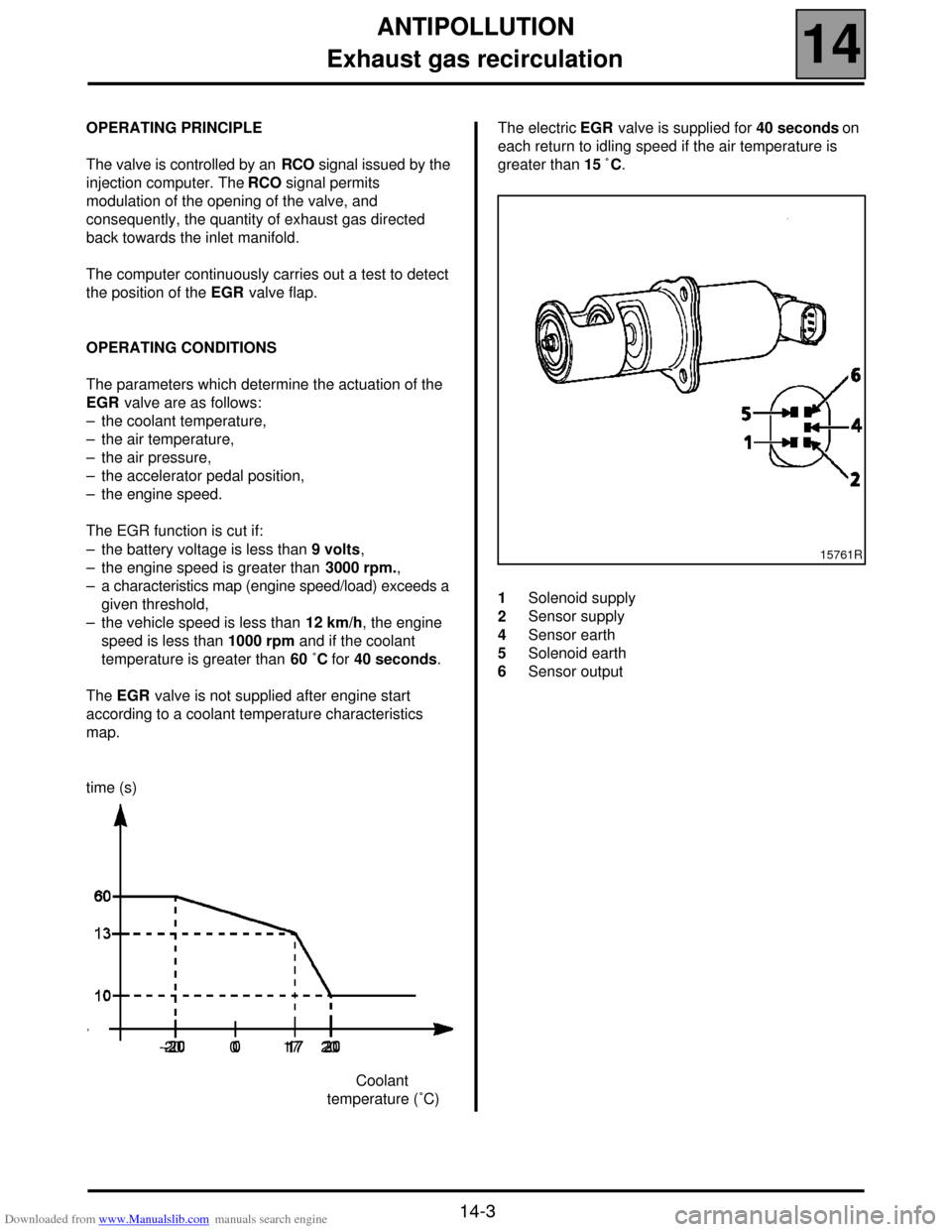
Downloaded from www.Manualslib.com manuals search engine ANTIPOLLUTION
Exhaust gas recirculation
14
14-3
OPERATING PRINCIPLE
The valve is controlled by an RCO signal issued by the
injection computer. The RCO signal permits
modulation of the opening of the valve, and
consequently, the quantity of exhaust gas directed
back towards the inlet manifold.
The computer continuously carries out a test to detect
the position of the EGR valve flap.
OPERATING CONDITIONS
The parameters which determine the actuation of the
EGR valve are as follows:
– the coolant temperature,
– the air temperature,
– the air pressure,
– the accelerator pedal position,
– the engine speed.
The EGR function is cut if:
– the battery voltage is less than 9 volts,
– the engine speed is greater than 3000 rpm.,
– a characteristics map (engine speed/load) exceeds a
given threshold,
– the vehicle speed is less than 12 km/h, the engine
speed is less than 1000 rpm and if the coolant
temperature is greater than 60 ˚C for 40 seconds.
The EGR valve is not supplied after engine start
according to a coolant temperature characteristics
map.
time (s)The electric EGR valve is supplied for 40 seconds on
each return to idling speed if the air temperature is
greater than 15 ˚C.
Coolant
temperature (˚C)
15761R
1
2
4
5
6Solenoid supply
Sensor supply
Sensor earth
Solenoid earth
Sensor output
-20 0 17 20
Page 102 of 118
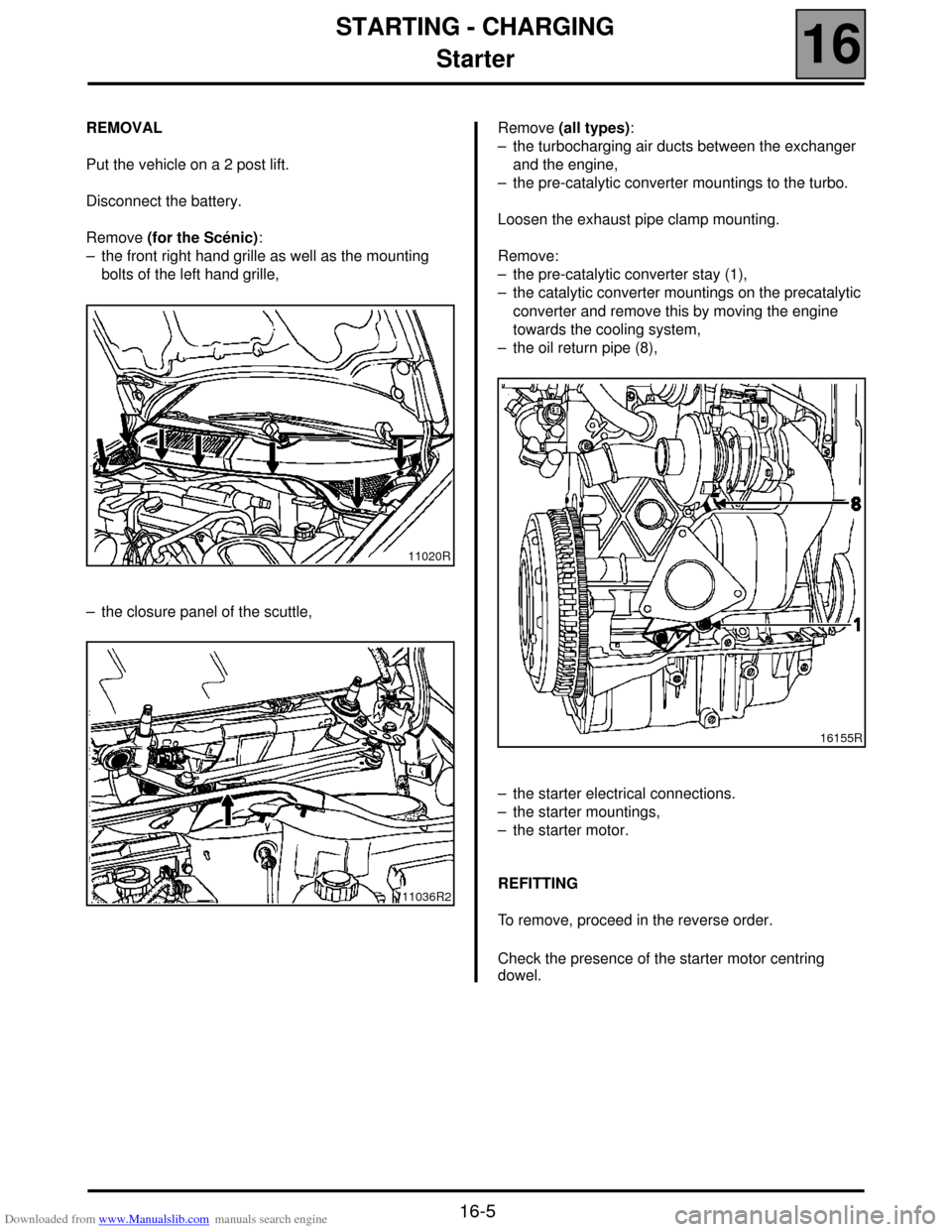
Downloaded from www.Manualslib.com manuals search engine STARTING - CHARGING
Starter
16
16-5
REMOVAL
Put the vehicle on a 2 post lift.
Disconnect the battery.
Remove (for the Scénic):
– the front right hand grille as well as the mounting
bolts of the left hand grille,
– the closure panel of the scuttle,Remove (all types):
– the turbocharging air ducts between the exchanger
and the engine,
– the pre-catalytic converter mountings to the turbo.
Loosen the exhaust pipe clamp mounting.
Remove:
– the pre-catalytic converter stay (1),
– the catalytic converter mountings on the precatalytic
converter and remove this by moving the engine
towards the cooling system,
– the oil return pipe (8),
– the starter electrical connections.
– the starter mountings,
– the starter motor.
REFITTING
To remove, proceed in the reverse order.
Check the presence of the starter motor centring
dowel.
11020R
11036R2
16155R